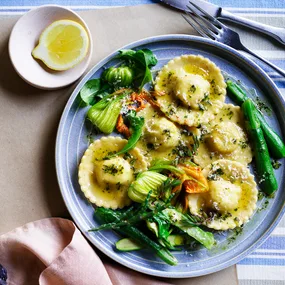Starting with a live lobster is paramount for the success of this dish. It’s equally important to kill the lobster humanely according to RSPCA guidelines. I recommend you place it in a container in the freezer for 45 minutes. Check after 30 minutes to make sure there is no movement in the legs and to ensure the flesh isn’t beginning to freeze.
A relatively modern part of the French canon, lobster à l’Américaine has a confusing provenance. It was known as early as 1860 in Paris where, one popular theory has it, it was created by a French chef named Pierre Fraisse who had lived and worked in the US, hence the name. Elizabeth David, however, points out in her French Provincial Cooking, that chef Fraisse was from the port town of Sète in the Languedoc, where olive oil, tomatoes and garlic were traditional ingredients, so his birthplace was the more likely inspiration. Other sources suggest it was called à l’Armoricaine from Armorica, the Gallic name for Brittany and surrounds, but those ingredients, as David points out again, were not part of that region’s cuisine.
I’ve found a number of recipes for lobster à l’Américaine with slight variations, but they all agree that live lobster is critical to a genuine result. Olive oil, onion, carrot, shallot, white wine or vermouth, fish stock, meat glaze, flamed Cognac and tomatoes are common to all professional recipes. Cayenne pepper is often used, and French tarragon and parsley, but what really makes the difference is using the tomalley or “coral” (the greenish delicacy found inside) from a female lobster to make the composite butter that binds the sauce.
While “elaborate” seems an appropriate description of this dish, one shouldn’t be frightened of cooking it – this is one of the most delicious dishes I have ever eaten and well worth the effort. One needs to adopt the restaurant approach in the mise en place, or preparation: cut, dice and measure all the ingredients first so once the cooking starts it flows smoothly. Ask your fishmonger for a female lobster; check that the legs next to the tail have two claws since males only have one. If you need to buy the rock lobster up to a day in advance of cooking don’t refrigerate it; simply place it in a secure container and cover it with a bath towel, then store it in a coolish dark place. Before you start, put the lobster in the freezer for about 45 minutes or until it shows no movement. I take the extra step of piercing the head between the eyes to be sure the creature is dead.
The main difference between European and American lobster and rock lobster is the absence of pincer claws on the latter; these large weapons contain generous amounts of flesh. Rock lobsters are also known as spiny lobsters or crawfish in the US. In Australia we use the names lobster, rock lobster, crayfish and I have also heard the term crawfish, which seems odd.
There are minor differences in the weight, structure and texture of the shells between animals in waters from the north, south and west of the country. Tasmanian or southern rock lobsters have a thinner shell than those found in Sydney Harbour and Western Australia, both of which are very hard and tricky to portion neatly. All have a little sac in front of the eyes, which is the stomach and needs to be discarded. Have a little bowl and a teaspoon on hand to collect the precious tomalley, and it’s a bad idea to pre-portion rock lobster since it oxidises, so make this the final step before cooking.
Serve lobster à l’Américaine in a wide shallow dish, preferably with a lid to create a little theatre at the table upon opening it. The traditional accompaniment is a pilaf and the ideal wine match is a flinty sauvignon blanc or a good Chablis or Graves. Don’t forget to have fingerbowls on hand and extra linen napkins, since everyone will want to devour this stunningly delicious dish.










